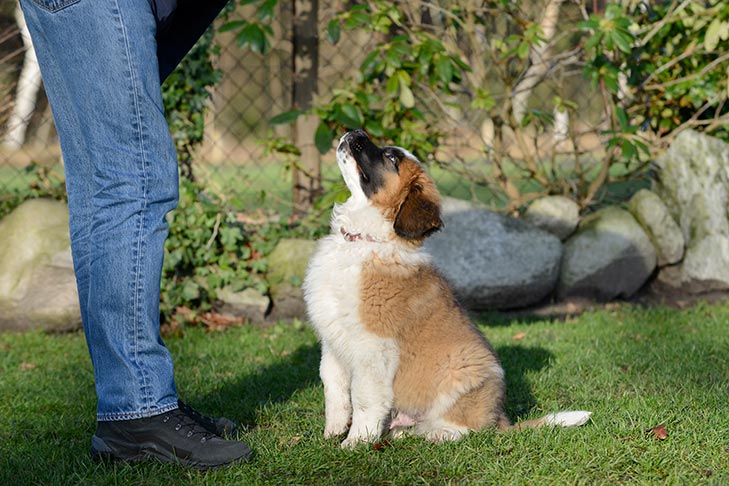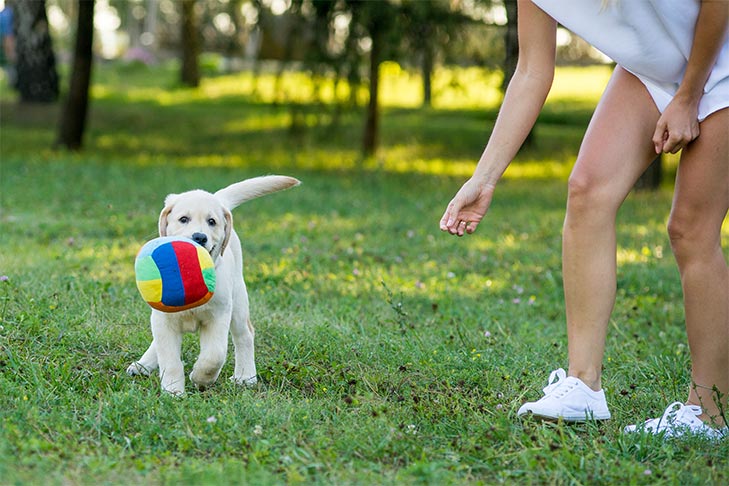
Your mother may not have had an advanced psychology degree, but when she told you to eat your vegetables in order to get dessert, she was on to something. Her advice was based on the Premack Principle, a rule proposed by psychologist David Premack, which states that high-probability behaviors, like eating dessert, will reinforce low-probability behaviors, like eating veggies. In other words, when it comes to dog training, things your dog is more likely to do — like chasing squirrels — can be used to reward him for doing things he’s less likely to do, like coming when called. In turn, this makes the less likely behaviors more likely to occur in the future.
There are tons of things your canine companion wants, such as going outside, greeting other dogs, or chasing a ball, and you can think of these things as life rewards. Rather than approaching training as a way of preventing your dog from getting what he wants, take advantage of life rewards and teach him that he can have what he wants if he gives you what you want first. For example, you don’t want your dog dashing out the door uninvited. But you can show him that if he sits and waits for permission, you will let him go through. He can perform the less likely behavior of sitting patiently for a chance to do the more likely behavior of going through the door. Next thing you know, your dog will be happy to wait at doorways.
Fetch is another example. Your dog probably enjoys chasing after a ball more than he enjoys bringing it back. However, with enough repetition, he learns that for you to throw the ball again (what he really wants) he needs to place it within your reach. If he performs the less likely behavior of giving away the ball, he can engage in the more likely behavior of chasing it. It won’t take long until he’s enthusiastically giving you the ball. So, the first step in harnessing the Premack Principle is taking stock of what your dog really wants to do. Understand how he ranks the value of all his options, so you can ask for the right trade when training.

Consider loose leash walking. Your dog wants to smell the shrubs, run to the nearest fire hydrant, or greet other pedestrians more than he wants to walk calmly at your side. You can use the behaviors he wants to do to reward the loose leash walking behavior you want. Rather than never letting your dog take a sniff break or say hello to other people, make those activities contingent upon the leash hanging slack. In the beginning, ask for only a few steps, then release your dog to sniff or greet. As he begins to catch on, you can ask for longer distances until you eventually pass some of those distractions without stopping at all.
Training your dog to come when called can also benefit from the Premack Principle. When training a reliable recall, you should never call your dog away from something fun. For example, if you call your dog in from chasing squirrels in the yard, then close the door and keep him in the house, you have actually punished him for coming when called — at least from your dog’s point of view. The same is true if you call your dog and then do something he considers unpleasant, like putting him in the bath or clipping his nails. What’s in it for him to come the next time you call?
But, what if you call your dog away from something fun, only to let him go back to it right away? That’s taking advantage of Premack. Ask your dog to “come,” and when he responds, reward him with praise, a treat, a toy, etc., then release him to go back to what he was doing in the first place. Your dog will realize that doing what you want, stopping his playtime and going to see you, means he will not only get a reward when he comes to you, but he will also get a second reward when you release him to go back to his fun. What a great way to strengthen your recall training and ensure you can call your dog away from any distraction when it counts for safety.
Get creative and think of all the ways you can have your dog doing what you want for a chance to do what he wants. Let the Premack Principle work for you. Eventually, those low-probability behaviors, like sitting patiently, walking calmly, or coming when called, will become high-probability behaviors because your dog will have learned to associate them with the things he loves. Pretty soon, he’ll want his veggies just as much as his dessert.

